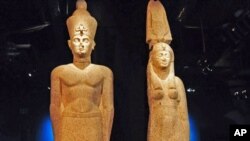No matter what image the name Cleopatra conjures up - a seductress who swayed two Roman rulers, the actress Elizabeth Taylor or the tragic heroine in a play by William Shakespeare - Egypt's last queen continues to fascinate and intrigue more than 2,000 years after her death. A new exhibit in Philadelphia, Pennsylvania, uses several recent discoveries to give visitors a glimpse of the real Cleopatra.
Immersing visitors in the world of Cleopatra is one of the goals of the exhibit "Cleopatra: The Search for the Last Queen of Egypt," at the Franklin Institute. The show uses more than 150 artifacts in an attempt to give visitors a sense of Cleopatra's life and times - a mixture of Egyptian, Greek and Roman cultures.
After passing through a dimly-lighted entrance that features artifacts under the floor of the exhibit, a brightly-illuminated stone head of the god Serapis - a composite of the Egyptian deity Osiris and several Greek gods - stares out at viewers. Two colossal pink granite statues from ancient Heracleion also dominate the view. The entire section is bathed in a shimmering blue light that simulates an underwater environment.
The lighting effect helps to remind visitors how many of the artifacts were recovered: they were retrieved from the harbor of modern day Alexandria and the nearby Bay of Aboukir by Egyptologist Franck Goddio and a team of divers from the European Institute of Underwater Archaeology.
Working since 1992 with ancient sources, 19th Century maps and 20th century magnetic resonance imaging, Goddio's team was able to map the ancient city of Alexandria, erased by earthquakes, tidal waves, and war. The ancient sites of Canopus and Heracleion, where Cleopatra would have been a high priestess and was crowned Pharaoh, also have been discovered.
Curators also have reassembled most of a prayer altar that contains what may be the first known astrological chart and the ancient Egyptian calendar.
University of Pennsylvania Egyptologist and the head of the Penn Museum's Egyptology section - David Silverman - is curator of the exhibit. He said he hopes it dispels some of the misconceptions about Cleopatra and gives visitors a glimpse of her time.
"People know the name Cleopatra, but what about the history? And they're learning that we don't know all the answers, but they are also learning how we can find out some of the answers," said Silverman.
An accompanying audio tour attempts to provide some answers through an actress portrayal of Cleopatra. Visitors hear the queen describe the artifacts, as well as something of their history and purpose, including those dating from her torrid romance with Mark Antony - a relationship that ended with both of them committing suicide.
"Only glory awaits us," the audio narration by an actress portraying Cleopatra said. "I have chosen to die by the bite of an asp. The poison will slowly pulse through my blood. I will fall into a gentle sleep, and when I awake, I will be with Antony once more."
The answer to one question seems elusive in this exhibit - what did Cleopatra actually look like? A headless statue shows a shapely woman wrapped in a wafer-thin Greek dress. Other representations of Egypt's last queen - idealized portraits from temples on the Nile and from official statuary - also are on display. Silverman said some of the smallest artifacts - coins - offer visitors the best glimpse of Cleopatra.
"And these are dated to Cleopatra VII," said Silverman. "And you know, coins are actually closer to what she might have looked like. So she has a rather aquiline nose and a prominent chin and, like many Greeks, probably had curly hair."
The last part of the exhibit looks at another mystery surrounding Cleopatra - where is her tomb? Excavations by Zahi Hawass, the secretary general of Egypt's Supreme Council of Antiquities highlight this section. Hawass and a team have been excavating a site near Taposiris Magna, about 30 kilometers west of modern Alexandria.
In a video presentation, Hawass makes the case for this site being a probable location of Cleopatra's tomb - there are coins from her time, artifacts from the Roman era, and there also is a large necropolis or burial ground featuring people of noble birth. So far Cleopatra's tomb has not been found but - experts note - only a small percentage of the site has been excavated.
Silverman said he would not be surprised if the tomb is found where it was least expected - like that of another famous Egyptian leader - Tutankhamen - whose tomb was found in 1922 by Howard Carter in the Valley of the Kings near Thebes.
"And remember the least of the likely spots in the Valley of the Kings that Howard Carter saved for last because it was unlikely, was under the workmen's huts from the later new kingdom," said Silverman. "And he only worked there because it was the last spot left. But it was not where a royal burial should have been and certainly not one from the 18th Dynasty."
"Cleopatra: The Search for the Last Queen of Egypt" continues at the Franklin institute until January 2, 2011.








